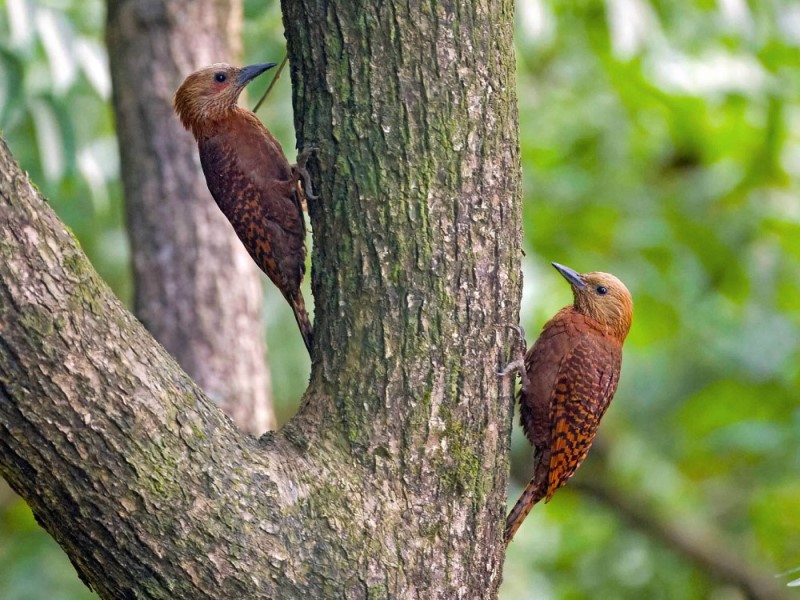Rufous Woodpecker Micropternus brachyurus 栗啄木鳥
Category I. Accidental with only two records, last reported in 1974.
IDENTIFICATION

Jul. 2010, Fujian, China. Koel Ko. Male (left).
21 - 24cm. A rather small woodpecker, dark rufous, heavily barred black on the wings and uppertail, with more diffuse barring on the belly, vent and undertail. Separated from the larger and paler Bay Woodpecker, the only likely confusion species in HK, by its solidly black bill (that of Bay Woodpecker is always pale yellow), whilst the male has a red patch below the eye (that of Bay Woodpecker is on the nape). The nape feathers are sometimes raised to form a shaggy crest.
VOCALISATIONS
The advertisement or territorial call is a rolling series of notes that falls slightly in pitch.
Also has a distinctive slow, deep drumming.
OCCURRENCE
There are two records, the second of which referred to a minimum of two individuals over a four year period:
1959: one at Repulse Bay, Hong Kong Island on 6 May 1959.
1970 – 1974: one at She Shan, Lam Tsuen Valley on 21 February, 26 April and 3 May 1970; a male and female there on 3 January, and one on 1 May 1971; a male on 5 February and 17 December 1973, and one on 15 January 1974. These are all the dates for which records were submitted and published; however, it should be noted that supporting descriptions were only provided for three of the observations, those in 1971 and 1973. In the absence of evidence to the contrary it is assumed that no more than two birds were involved.
The 1959 Repulse Bay record is well-documented, but the location on HK Island and, to a lesser extent the date, are very unusual for what must be presumed to relate to a wandering or dispersing individual from south China. In this context, it is perhaps relevant to note that, following a review reported by Carey et al. (2001), Great-spotted Woodpecker Dendrocopos major, for which there were four HK records three of which were from HK Island, was placed in Category III as all records were considered likely to refer to ex-captive birds.
Considerably less doubt as to their origin is attached to the cluster of records at She Shan. The fung shui wood at the latter location (which currently covers about 6ha) was known as a hotspot for forest bird species from the 1930s and was probably one of the older and larger patches of woodland in HK in the early 1970s and thus is a likely destination for a dispersing forest bird.
RANGE & SYSTEMATICS
The range extends from the Himalayas through most of southern India east and south through mainland southeast Asia and the Greater Sundas to west Java (Winkler and Christie 2020). In China it occurs from extreme southeast Tibet and Yunnan east through Guangxi, Guangdong and south Hunan as far north and east as Jiangxi and south Zhejiang, as well as Hainan (Liu and Chen 2021). There are ten subspecies, of which three occur in China: M. b. phaioceps in Tibet and Yunnan, M. b. fokiensis in the remainder of the mainland range and M. b. holroydi in Hainan. Like Grey-headed Woodpecker, the closest locations to HK listed by Lewthwaite (1996) were in northern Guangdong, but recent eBird reports suggest that it is found in hill forests east of Guangzhou, approximately 100km from HK (eBird 2024).
CONSERVATION STATUS
IUCN: Least Concern. Population trend decreasing.
Carey, G. J., M. L. Chalmers, D. A. Diskin, P. R. Kennerley, P. J. Leader, M. R. Leven, R. W. Lewthwaite, D. S. Melville, M. Turnbull & L. Young (2001). The Avifauna of Hong Kong. Hong Kong Bird Watching Society, Hong Kong.
eBird. 2024. eBird: An online database of bird distribution and abundance [web application]. eBird, Cornell Lab of Ornithology, Ithaca, New York. Available: http://www.ebird.org. (Accessed: 14 June 2024).
Lewthwaite, R. W. (1996). Forest birds of Southeast China. Hong Kong Bird Report 1995: 150-203.
Liu, Y. and S. H. Chen (eds) (2021). The CNG Field Guide to the Birds of China (in Chinese). Hunan Science and Technology Publication House, Changsha.
Winkler, H. and D. A. Christie (2020). Rufous Woodpecker (Micropternus brachyurus), version 1.0. In Birds of the World (J. del Hoyo, A. Elliott, J. Sargatal, D. A. Christie, and E. de Juana, Editors). Cornell Lab of Ornithology, Ithaca, NY, USA. https://doi.org/10.2173/bow.rufwoo2.01

